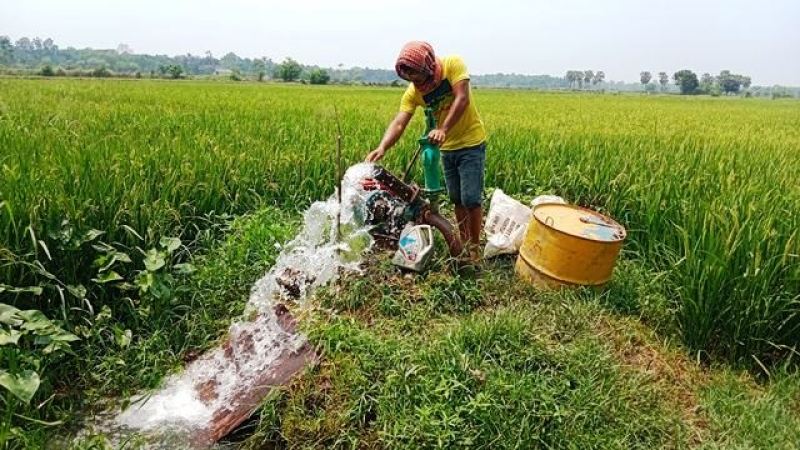- CA Yunus pays homage to Liberation War martyrs on Victory Day |
- Bangladesh capital market extends losing streak for second day |
- Bangladesh celebrates Victory Day Tuesday |
- 'Different govts presented history based on their own ideologies': JU VC |
Salinity ingress from sea shrinks farmlands in Narail, Bangladesh

A farmer in Narail lifting water from a tube well in Narail, in southwestern Bangladesh
By Alamgir Siddique
Narail, April 27 – Once a vibrant tapestry of lush, emerald fields swaying under the golden sun, Narail’s farmland now bears the heavy scars of an insidious enemy — salinity.
Across the district’s rivers and canals, salt is stealthily tightening its grip, casting a long shadow over the livelihoods of thousands of farmers.
Where once farmers gleefully drew life from the surface waters, today they find themselves shackled by the bitter reality of saline rivers and canals.
Forced to abandon traditional irrigation methods, they now turn to the bowels of the earth for groundwater, a desperate measure that is doubling their production costs and dimming the hopes of an agricultural bounty.
Gone are the days when Narail’s fertile fields would yield three crops a year.
Now, in many areas, farmers struggle to coax even a single harvest from the stubborn soil — a plight that weighs heaviest on the district’s marginal farmers.
Dr Md Motasim Ahmed, Chief Scientific Officer of the Soil Resource Development Institute in Jashore, paints a grim picture.
Speaking of the rivers — the Madhumati at Kalnaghat in Lohagara upazila, the Nabaganga at Baroipara in Kalia upazila, and the Chitra and Afra rivers in Narail Sadar upazila — he notes that these once-bountiful waterways now suffer from seasonal salinity.
It was back in 2000 that the first signs of trouble surfaced: salinity detected across some 16,000 hectares of land.
By 2009, the affected area had expanded to around 19,000 hectares — a creeping blight whose full extent today remains unknown, as the results of last year’s survey have yet to be unveiled.
Dr Motasim explains that the flow of freshwater from upstream, particularly from the Farakka Barrage, plays a decisive role. “Higher water flow could reduce salinity levels,” he says, “while reduced flow only deepens the crisis.”
Rainfall, too, holds sway — abundant rains wash away salt, while drought years leave the land parched and saline-choked.
According to Dr Motasim, the acceptable threshold for irrigation water salinity stands at 0.75 deciSiemens per metre (dS/m).
Disturbingly, water samples from Narail’s rivers and canals reveal salinity levels reaching a staggering 1.75 dS/m — rendering the water unsuitable for cultivation.
The stakes are high. The Department of Agricultural Extension (DAE) in Narail reports that the district — spread across 968 square kilometres and home to about 800,000 souls — relies overwhelmingly on agriculture and fisheries, with nearly 82 percent of its people drawing their sustenance from these endeavours.
Boro rice cultivation, a seasonal ritual for marginal farmers, now teeters on the brink. Farmers like Pabitra Majumdar from Bashvita village in Sadar upazila share a story of struggle and heartbreak.
"Fifteen years ago, I could irrigate my land using river or canal water," he reminisces wistfully. "But now, the water has become too saline."
Forced to rely on groundwater, Pabitra spent about Tk 22,000 this year on irrigation for his two acres of land — a cost that would have been significantly lower had surface water remained viable.
Across Narail, the tale repeats itself. In Kalia upazila’s Kanchanpur village, Pickul Sheikh recounts his burden, "Earlier, I needed Tk 2,500 to irrigate one bigha (33 decimals) of land. Now, extracting groundwater costs me Tk 7,000 to 8,000 per bigha."
The salty siege has not only driven up costs but also ravaged crops and soils, compelling farmers to pour even more fertiliser into their withering fields.
"We used to grow three crops a year," laments Pickul. "Now, due to rising costs and saline water, we sometimes cannot even produce one crop."
Narail Sadar Upazila Agriculture Officer, Md Rokonuzzaman, acknowledges the dire circumstances.
Farmers, he says, are battling soil degradation by using more fertilisers — an expensive and often futile effort.
Amidst the despair, glimmers of hope persist. Farmers are being encouraged to cultivate salt-tolerant crops, adapting to the new realities with resilience and innovation.
Md Jasim Uddin, Deputy Director of the Department of Agricultural Extension in Narail, stresses the importance of revitalising the region’s natural irrigation systems.
"Canals in many low-lying areas have silted up, reducing tidal flow and freshwater availability," he observes.
"We need to re-excavate these canals to increase the flow of sweet water. If farmers can once again use river and canal water for irrigation, their costs will go down and they can return to growing three crops annually," he added.
He further highlights efforts to promote the cultivation of salt-tolerant varieties of paddy, wheat, maize, and sunflower, with agricultural officers working tirelessly in the fields to guide and support the farmers.
Yet the salinity crisis gripping Narail is but a reflection of a greater calamity unfolding across Bangladesh’s southern coastal belt.
Rising sea levels, more frequent cyclones, and upstream freshwater withdrawal have conspired to drive saline waters deeper inland, particularly during the arid dry season.
Districts such as Khulna, Satkhira, Bagerhat, and parts of Barisal are bearing the brunt of this saline onslaught, as once-fertile lands fade into barrenness, threatening the livelihoods of millions and posing grave concerns for food security in the nation.
In Narail, the farmers’ battle against the creeping salt is both a fight for survival and a testament to their undying spirit — as they dig deeper, quite literally, for the waters that once flowed freely under the open skies. - UNB

